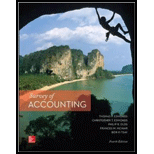
Concept explainers
a.
Compute the
a.
Explanation of Solution
Double-declining-balance method:
It is an accelerated method of depreciation under which the depreciation declines in each successive year until the value of asset becomes zero. Under this method, the book value (original cost less
Compute the depreciation expense for five years, using double-declining-balance depreciation.
| Date | Double-Declining-Balance Depreciation Rate (A) | Book Value (Refer note) (in $) (B) | Depreciation expense (in $) |
| 2014 | 0.40 | 47,000 | 18,800 |
| 2015 | 0.40 | 28,200 | 11,280 |
| 2016 | 0.40 | 16,920 | 6,768 |
| 2017 | 0.40 | 10,152 | 3,152 |
| 2018 | 0.40 | 7,000 | 0 |
Table (1)
Note:
Book value:
The amount of acquisition cost of less accumulated depreciation as on a particular date is referred to as book value.
Accumulated depreciation:
The total amount of depreciation expense deducted, from the time asset acquired till date, as reported in the account as on a particular date, is referred to as accumulated depreciation.
Determine the depreciation rate applied each year.
Useful life = 5 years
Compute depreciation expense on 2017:
Hence, the depreciation expenses for each of the five years, using double-declining-balance depreciation are $18,800, $11,280, $6,768, $3,152 and $0 respectively.
b.
Compute the depreciation expense for each of the five years, using units-of-production depreciation.
b.
Explanation of Solution
Units-of-production method:
Under this method of depreciation, the depreciation expense is calculated on the basis of units produced in a year. This method is suitable when a company has fluctuating productive rate.
Compute the depreciation expense for each of the five years, using units-of-production depreciation:
| Date | Depreciation per unit (A) | Number of copies (B) | Depreciation expense (in $) |
| 2014 | $0.02 | 560,000 | 11,200 |
| 2015 | $0.02 | 490,000 | 9,800 |
| 2016 | $0.02 | 430,000 | 8,600 |
| 2017 | $0.02 | 350,000 | 7,000 |
| 2018 | $0.02 | 210,000 | 3,400 |
Table (2)
Compute depreciation per unit:
Compute depreciation expense on 2018:
Hence, the depreciation expenses for each of the five years, using units-of-production depreciation are $11,200, $9,800, $8,600,$7,000 and $3,400 respectively.
c.
Calculate the gain or loss from the sale of the asset under each of the depreciation methods.
c.
Explanation of Solution
A schedule to calculate the gain or loss on the sale of the copier under double-declining balance depreciation is as follows:
| Particulars | $ | $ |
| Consideration received | 7,600 | |
| Less: Book value: | ||
| Cost of the copier | 47,000 | |
| Accumulated depreciation | (40,000) | (7,000) |
| Gain on sale of copier | $ 600 |
Table (3)
A schedule to calculate the gain or loss on the sale of the copier under units-of-production depreciation is as follows:
| Particulars | $ | $ |
| Consideration received | 7,600 | |
| Less: Book value: | ||
| Cost of the copier | 47,000 | |
| Accumulated depreciation | (40,000) | (7,000) |
| Gain on sale of copier | $ 600 |
Table (4)
Working Note 1: Calculate the accumulated depreciation under double-declining-balance depreciation.
Working Note 2: Calculate the accumulated depreciation under units-of-production depreciation.
Hence, the gain from the sale of the asset under double-declining-balance depreciation and units-of-production depreciation are the same amount of $600.
Want to see more full solutions like this?
Chapter 6 Solutions
Survey Of Accounting
- Questi 2arrow_forwardProvide right Answerarrow_forwardMusk Jewellers wants to apply a markup of 35% based on the selling price for a goldbracelet. If the store paid $4,160.00 for the bracelet, how much should it be sold for to achieve the desired markup? a. $6,400.00 b.$5,600.00 c. $4,800.00 d. $3,120.00arrow_forward
- Give me this question answerarrow_forwardA firm has a market value equal to ns book value Currently, the firm has excess cash of s800, other assets of $5.200, and equity of $6.000 The firm has 600 shares of stock outstanding and a net income of $500. The firm has decided to spend half of its excess cash on a share repurchase program How many shares of stock we be outstanding after the stock repurchase is completed? Please show me how to solve this financial accounting problem using valid calculation techniques.arrow_forwardFinancial accounting problemarrow_forward
- A firm has a market value equal to ns book value Currently, the firm has excess cash of s800, other assets of $5.200, and equity of $6.000 The firm has 600 shares of stock outstanding and a net income of $500. The firm has decided to spend half of its excess cash on a share repurchase program How many shares of stock we be outstanding after the stock repurchase is completed?arrow_forwardHaven Manufacturing applies manufacturing overhead to jobs based on machine hours used. Overhead costs are expected to total $350,000 for the year, and machine usage is estimated at 140,000 hours. For the year, $365,000 of overhead costs are incurred, and 150,000 hours are used. Compute the manufacturing overhead rate for the year.arrow_forwardPlease explain this financial accounting problem with accurate financial standards.arrow_forward

 AccountingAccountingISBN:9781337272094Author:WARREN, Carl S., Reeve, James M., Duchac, Jonathan E.Publisher:Cengage Learning,
AccountingAccountingISBN:9781337272094Author:WARREN, Carl S., Reeve, James M., Duchac, Jonathan E.Publisher:Cengage Learning, Accounting Information SystemsAccountingISBN:9781337619202Author:Hall, James A.Publisher:Cengage Learning,
Accounting Information SystemsAccountingISBN:9781337619202Author:Hall, James A.Publisher:Cengage Learning, Horngren's Cost Accounting: A Managerial Emphasis...AccountingISBN:9780134475585Author:Srikant M. Datar, Madhav V. RajanPublisher:PEARSON
Horngren's Cost Accounting: A Managerial Emphasis...AccountingISBN:9780134475585Author:Srikant M. Datar, Madhav V. RajanPublisher:PEARSON Intermediate AccountingAccountingISBN:9781259722660Author:J. David Spiceland, Mark W. Nelson, Wayne M ThomasPublisher:McGraw-Hill Education
Intermediate AccountingAccountingISBN:9781259722660Author:J. David Spiceland, Mark W. Nelson, Wayne M ThomasPublisher:McGraw-Hill Education Financial and Managerial AccountingAccountingISBN:9781259726705Author:John J Wild, Ken W. Shaw, Barbara Chiappetta Fundamental Accounting PrinciplesPublisher:McGraw-Hill Education
Financial and Managerial AccountingAccountingISBN:9781259726705Author:John J Wild, Ken W. Shaw, Barbara Chiappetta Fundamental Accounting PrinciplesPublisher:McGraw-Hill Education





